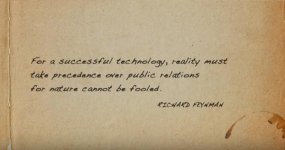It's not like he invented the technique or that it went out of style.
It's worse now than ever before.
No argument from me.
se
You are arguing all these days over what exactly? (“For the poets don’t like to be understood”)
If you would spare 1:17:57 away from this forum and notice what is been said here
https://www.youtube.com/watch?v=xdZMXWmlp9g
George
If you would spare 1:17:57 away from this forum and notice what is been said here
https://www.youtube.com/watch?v=xdZMXWmlp9g
George
Attachments
Or you can just guess. It's far easier, quicker, and just as effective............🙄The key to dowsing is to go into a meditative state, exclude every thought from your mind, and sense for changes in local ground radiations/fields..
You are arguing all these days over what exactly?
Frustrating isn't it?
You are arguing all these days over what exactly? (“For the poets don’t like to be understood”)
If you would spare 1:17:57 away from this forum and notice what is been said here
https://www.youtube.com/watch?v=xdZMXWmlp9g
George
Who knows? Who cares? Does it matter?
I have found my note, he said 0.5V. Just so in passing, it was no bragging contest.
Sorry, I simply meant I have never seen any effect that would qualify as huge. For instance the 5534 does not have a reputation for huge 1/f noise difference with common mode voltage. Most op-amps will have cascodes and operate at ~0 Vcb, but AFAIK the 5534 and LM833 do not and neither has a high 1/f corner.
EDIT -reference with measurements of opposite effect, http://tf.boulder.nist.gov/general/pdf/1139.pdf
Last edited:
OPA1642
Speaking of common-mode effects, has anyone looked carefully at the TI OPA1642? From the simplified schematic on the datasheet, it appears the input stage is a rather simple NJFET pair and a ballasted PNP current mirror --- no cascoding etc. So I would expect the common-mode distortion to be fairly high.
However, they may have omitted some crucial details.
Speaking of common-mode effects, has anyone looked carefully at the TI OPA1642? From the simplified schematic on the datasheet, it appears the input stage is a rather simple NJFET pair and a ballasted PNP current mirror --- no cascoding etc. So I would expect the common-mode distortion to be fairly high.
However, they may have omitted some crucial details.
Speaking of common-mode effects, has anyone looked carefully at the TI OPA1642? From the simplified schematic on the datasheet, it appears the input stage is a rather simple NJFET pair and a ballasted PNP current mirror --- no cascoding etc. So I would expect the common-mode distortion to be fairly high.
However, they may have omitted some crucial details.
Please see the attached file, OPA1641 was measured.
Attachments
Speaking of common-mode effects, has anyone looked carefully at the TI OPA1642? From the simplified schematic on the datasheet, it appears the input stage is a rather simple NJFET pair and a ballasted PNP current mirror --- no cascoding etc. So I would expect the common-mode distortion to be fairly high.
However, they may have omitted some crucial details.
The input common mode range is only 3.5V to the + rail so possibly the schematic is over simplified as there might be room for a cascode.
Thanks! Very interesting.Please see the attached file, OPA1641 was measured.
Scott, but he is right, distortion of that opamp is not very low.
Right, never measured it myself.
I was looking at the part for a budget MM phono pre application, and noted the 5.1nV/sq rt Hz noise density, the preceding part having been the OPA2134.
But I think I will allow a trifle higher parts count and use an AD797 or LME49990 preceded by a BF862 cascoded source follower and servo. The overall input voltage noise will still be acceptably small, although could be reduced by a more elaborate series feedback arrangement for the JFET. Things rapidly spiral into complexity, and I'd like frequency compensation to be simple for a change.
But I think I will allow a trifle higher parts count and use an AD797 or LME49990 preceded by a BF862 cascoded source follower and servo. The overall input voltage noise will still be acceptably small, although could be reduced by a more elaborate series feedback arrangement for the JFET. Things rapidly spiral into complexity, and I'd like frequency compensation to be simple for a change.
Yes. Along with the '34 its all the opamp one needs really, except as to GBW in some exotic circuits. It's my stock choice, cheap, easy, available in DIP and effective.NE5532 is good for audio band distortion. Who'da thunk it 🙂
But too much current noise for high inductance sensors.Yes. Along with the '34 its all the opamp one needs really, except as to GBW in some exotic circuits. It's my stock choice, cheap, easy, available in DIP and effective.
I was looking at the part for a budget MM phono pre application, and noted the 5.1nV/sq rt Hz noise density, the preceding part having been the OPA2134.
But I think I will allow a trifle higher parts count and use an AD797 or LME49990 preceded by a BF862 cascoded source follower and servo. The overall input voltage noise will still be acceptably small, although could be reduced by a more elaborate series feedback arrangement for the JFET. Things rapidly spiral into complexity, and I'd like frequency compensation to be simple for a change.
cascoded source follower? 😕
< http://www.analog.com/library/analogDialogue/archives/47-10/discrete_amplifier.pdf >
regards, Gerhard
No argument from me.
se
Steve and I agreed on something. Everyone mark that on your calendar, or in your diary...😛
- Status
- Not open for further replies.
- Home
- Member Areas
- The Lounge
- John Curl's Blowtorch preamplifier part II
